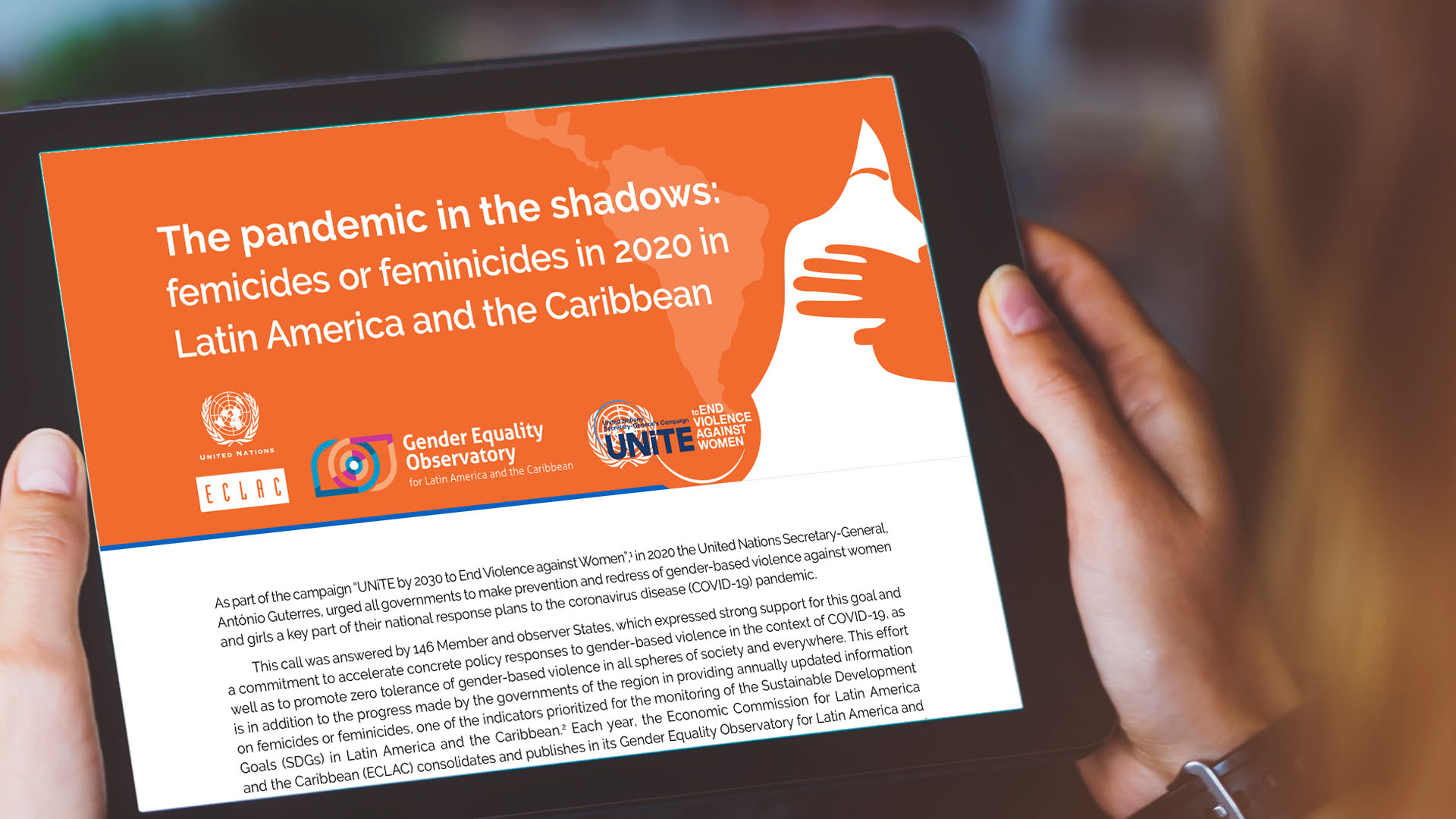ECLAC: At Least 4,091 Women Were Victims of Femicide in 2020 in Latin America and the Caribbean, Despite Greater Visibility and Social Condemnation
Work area(s)
The United Nations regional organization’s Gender Equality Observatory released today the latest statistics available on this true “shadow pandemic.”

Femicide, or feminicide, as an extreme and lethal form of gender violence continues to affect thousands of women and girls each year in Latin America and the Caribbean, despite an increase in its visibility, state responses and the pressure applied by women’s movements, which have massively expressed their rejection of gender violence throughout the region, the Economic Commission for Latin America and the Caribbean (ECLAC) warned today upon presenting a new report.
At least 4,091 women were the victims of femicide in 26 countries (17 in Latin America and 9 in the Caribbean) in 2020, marking a reduction of 10.6% versus 2019, when 4,576 cases were reported, according to data from the Commission’s Gender Equality Observatory for Latin America and the Caribbean, which each year consolidates and updates the figures on femicide and women’s violent, gender-based deaths that are provided by governments.
It is important to note that this regional indicator is an approximation because there is still no common methodology used to generate standardized statistics on this crime, ECLAC explains.
In Latin America, the highest femicide rates are reported in Honduras (4.7 for every 100,000 women), the Dominican Republic (2.4 per 100,000 women) and El Salvador (2.1 per 100,000 women), although these three countries all saw their figures decline versus 2019, as did Bolivia, Brazil, Colombia, Guatemala, Paraguay, Puerto Rico and Uruguay.
Honduras went from 6.1 femicides for every 100,000 women in 2019 to 4.7 per 100,000 women in 2020, while the rate in the Dominican Republic declined from 2.7 to 2.4 and that of El Salvador fell from 3.3 to 2.1.
The 2020 femicide rates in Argentina, Chile, Mexico and Nicaragua held steady from 2019, while rising in Ecuador, Costa Rica and Panama when compared with the year before. Out of those countries, Panama reported the most significant increase, ECLAC indicates.
In the English-speaking Caribbean, four out of the nine countries and territories with data available on violent, gender-based deaths saw an increase in the rate per 100,000 women between 2019 and 2020. In Grenada, the rate jumped from 1.9 to 5.5 per 100,000 women; in Saint Vincent and the Grenadines, from 0 to 5.5; in Suriname, from 1.1 to 2.8; and in Trinidad and Tobago, it rose from 2.9 to 3.1. It is worth highlighting that none of the countries or territories of this subregion has classified femicide, or feminicide, as a criminal offense.
“We will never tire of shedding light on the violence that affects women and girls in the region on a daily basis and that has repercussions for society as a whole, since it constitutes an obstacle to achieving equality as well as sustainable development and peace,” Alicia Bárcena, ECLAC’s Executive Secretary, declared in the framework of the International Day for the Elimination of Violence against Women, which is commemorated each year on November 25 and which launches 16 days of activism through to December 10, which is International Human Rights Day.
In 2021, this call has become even more urgent with the expansion of the UNiTE by 2030 to End Violence against Women campaign, which seeks to mobilize governments, civil society, women’s organizations, young people, the private sector, the media, and the entire United Nations system to join forces to address the global pandemic of violence against women and girls.
Femicide violence is present throughout the life cycle of women, although it exhibits greater intensity during women’s reproductive years, the Commission notes.
In absolute terms, in 18 of the 26 countries that report to ECLAC, the highest number of cases of femicide in 2020 corresponded to the age range of between 30 and 44 years (344 women). Adolescents and young adult women from between 15 and 29 years of age were the group with the second-highest incidence of femicide, with 335 victims in 2020. The situation of girls and adolescents in the region also sounds an alarm, according to ECLAC: at least 40 girls under 15 years of age were the victims of femicide.
Femicide not only affects the direct victims but also their circle, and their closest dependents in particular, the Commission emphasizes. At least 357 children and adolescents, as well as other dependents, were under the care of the femicide victims that were accounted for in 2020 in seven countries of Latin America: Argentina, Chile, Costa Rica, Nicaragua, Panama, Paraguay and Uruguay.
Although the region’s countries have made progress in the last decade in terms of producing statistics on femicide, national record-keeping systems need to be strengthened and the information must be standardized, to provide better data for analyzing the characteristics of this crime on a national level and to improve regional and international comparability, ECLAC sustains.
Social and institutional tolerance, impunity, and difficulties in accessing timely, quality health and judicial services – among other factors – contribute to a situation in which all forms of violence against women occur and are perpetuated, the Commission underscores.
In this regard, it is necessary to broaden the measurement and raise more awareness of other forms of violence that are part of the continuum of femicide violence – particularly sexual violence, which is very linked to femicide, since it is common for the murder of women and girls to be preceded by acts of sexual violence, carried out by perpetrators who have not necessarily had, or have, a sentimental or familial relationship with the victims.
The bolstering of the regulatory framework must be accompanied by other steps, such as developing evidence-based public plans and programs that would incorporate strategies for prevention and reparation, and strengthening and financing high-quality essential services, in addition to improving access to justice.
“Here at ECLAC we stress the importance of measurements on violence against women and girls becoming a central element in the framework of countries’ systems for information and official statistics. Today, preventing and making women and girls’ right to a violence-free life a reality is an urgent objective in the region that cannot be delayed,” Bárcena concluded.
Country(ies)
- Latin America and the Caribbean
